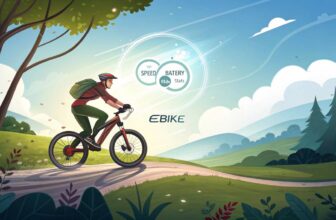DIY E-Bike Conversion Benefits
Money-Saving Bike Boost
DIY e-bike kits give your trusty bike a little boost without breaking the bank. Who knew turning your old bicycle into a zippy e-bike could be so wallet-friendly, right? Perfect for city cruisers, gym rats, or anyone who wants to step up their bike game without selling an arm and a leg.
| Factor | Cost Range |
|---|---|
| Basic Conversion Kit | $200 – $500 |
| Mid-Range Kit | $500 – $1,000 |
| High-End Kit | $1,000 – $2,000 |
Switching from pedal power to electric can save you some serious dough. Ditching the gas guzzler means holding onto more of your hard-earned cash. According to Instructables, these DIY projects can practically pay themselves off in a couple of years, slicing your driving distance in half and cutting down those pesky fuel costs. Delivery drivers and anyone tired of shelling out big bucks for car upkeep will find this appealing.
Curious about the conversion costs? Peek at our ebike build cost guide for more info.
Green Means Go
If saving trees and cutting carbon is your jam, then e-bikes are your new best friend. Transforming that old bike into an e-bike means fewer bikes junking up landfills and fewer resources spent making new ones. Really Good Ebikes says e-bikes spit out way less pollution than our beloved cars, making them the hero in the fight for fresher air.
Earth lovers and penny pinchers alike dig the DIY e-bike scene for maximum savings and minimal environmental impacts. They’re lightweight and use just a tiny jolt of electricity to run compared to old-school cars. They’re ideal for seniors and anyone looking for less joint-pain transportation with added mobility.
Check out the green perks of e-bikes in our article about ebike range factors.
Figuring out the perks of DIY e-bike conversions lets you score deals that don’t put a dent in your eco-conscience. For a trusty rundown on different e-bike kits and their bells and whistles, pop over to our pages on important e-bike conversion components and fan-favorite mid-drive motor kits.
Choosing the Right E-Bike Kit
Picking the perfect e-bike kit can turn your trusty old bike into an electric gem. There are a ton of choices out there, so figuring out what fits your ride and style is where it’s at.
What to Think About When Picking a Kit
When diving into the world of e-bike kits, some stuff is super important to nail down what’s best for you:
- Motor Type:
- Front Hub Motors: They’re a breeze to install and work great on flat surfaces.
- Mid-Drive Motors: Tricky to set up, but they balance the bike better and power up those hilly stretches.
- Battery Capacity:
- Keep an eye on voltage (V) and amp-hours (Ah). Bigger numbers mean more ride time but might make the bike heavier.
- Learn more about ebike battery voltage.
- Ease of Installation:
- Kits like Swytch replace the front wheel and have a handy handlebar-mounted battery, super easy to figure out.
- Weight:
- Lighter kits keep your bike nimble and easy to handle.
- Find out more about electric bike weight limits.
- Cost:
- Juggle what features you need with what you’re willing to spend.
- Check out the best cheap electric bikes for options that won’t break the bank.
Kit Price Range and Specs
E-bike kits range in price and what they offer, depending largely on the bells and whistles:
| Kit Name | Price Range (USD) | Motor Type | Battery | Features |
|---|---|---|---|---|
| Cytronex Electric Bike Kit | $750 – $900 | Front Hub | External | Lightweight, a total cinch to put on |
| Bafang Front Hub Motor Kit | $350 – $700 | Front Hub | Custom | A strong motor, adaptable wheel sizes, top-tier build |
| Rubbee X Electric Bike Kit | $800 – $1,100 | Hub | Integrated | Handy size, portable, install in a snap, decent range |
| Swytch Electric Bike Kit | $499 – $1,200 | Front Hub | External | A handy handlebar battery, with an LCD screen, gives a natural ride feel (Cyclingnews) |
Prices and specs might shift a bit if you’re looking at things like brand cred, customer support, and warranty deals. For the best conversion kits, check out more about electric bike conversion kits.
Getting the right e-bike kit means your regular bike’s ready to buzz on the roads. Make sure to balance these considerations for the best performance and bang for your buck. For more info on keeping your e-bike running smoothly, head to our guides on electric bike maintenance and ebike troubleshooting.
Notable E-Bike Conversion Kits
Thinking of turning your regular bike into a zippy e-bike? You’re in luck! Here’s the lowdown on some of the top e-bike conversion kits that can give your trusty two-wheeler an electrifying upgrade.
Cytronex Electric Bike Conversion Kit
The Cytronex conversion kit is a real gem for its smart design and solid engineering. No need for fancy tools – just some Allen keys and you’re good to go. Plus, it’s got a handy app to keep things running smoothly as butter (Cyclingnews). Sure, it’s a bit pricier, but its user-friendliness and quality make it popular with city commuters and folks who love Mother Earth.
| Feature | Description |
|---|---|
| Installation | A breeze with just Allen keys |
| Diagnostics | App-controlled |
| Operation | Extra smooth and durable |
| Price Range | Up there, but worth it |
Bafang Front Hub Motor Kit
The Bafang Front Hub Motor kit is one of the simplest ways to power up your bike. You can tweak wheel, display, and battery sizes to suit your needs, thanks to its robust motor and superior build. Though it takes a bit more effort to install compared to others, it’s a hit among fitness buffs and delivery folks.
| Feature | Description |
|---|---|
| Motor Type | Front Hub Motor |
| Customization | Lots – wheels, display, battery |
| Installation Complexity | Moderate |
| Value | High-quality kicker |
Rubbee X Electric Bike Conversion Kit
The Rubbee X kit makes converting easy-peasy. Just attach it to the seatpost, and its 250-watt motor takes care of business by driving the rear tire. It adjusts help depending on how fast you’re pedaling, and you can add more batteries for longer jaunts (Cyclingnews). Ideal for seniors or anyone who wants less legwork.
| Feature | Description |
|---|---|
| Motor Type | Rear Tire Drive |
| Installation | Seatpost mount |
| Motor Power | Packs a 250-watt punch |
| Assistance | Pedal-based |
| Battery Options | Plenty of choices |
Swytch Electric Bike Conversion Kit
Swytch has nailed it with their easy-to-use conversion kit. Swap out the front wheel for a motorized one, clip the battery to the handlebars, and you’re all set. The setup feels just like a regular ride but with an added boost – great for city slickers or those ditching the car for a bike.
The 2022 update brought a tidy new battery pack. Choose the lightweight Air battery for shorter trips or the beefier Max for longer rides. Either way, you’ll be rolling in about half an hour.
| Feature | Description |
|---|---|
| Motor Type | Front Wheel Motor |
| Installation | Swap out front wheel |
| Battery Options | Air (700g, 15km) or Max (1,100g, 30km) |
| LCD Display | Comes included |
| Installation Time | About 30 minutes |
Looking for more info on e-bike know-how? Check out our guides on ebike motor types and ebike battery voltage.
Road Bike Conversion Essentials
Turning your road bike into an e-bike is like upgrading your old clunker into a sleek, silent rocket – perfect for anyone tired of traffic jams or public transit chaos. Whether you’re commuting, getting fit, or just cruising around, know that a DIY e-bike conversion is an exciting, wallet-friendly project. Let’s chat about picking the right bike and why Luna Cycle’s kits are your new best friend.
Bike Suitability Considerations
Before you grab a wrench and go all “DIY master,” a quick bike check-up is needed. Here’s what to eyeball:
- Frame Material: You want something tough, like aluminum or steel. For the nitty-gritty details, check out our info on ebike frame materials.
- Brake System: As your new e-bike hits the juice, your old brakes need to be top-notch. Need suggestions? We got you covered with electric bike brakes.
- Fork Compatibility: Make sure your bike’s fork can take the added muscle from the motor and battery.
- Clearance and Space: Scope out enough room to mount the goodies without cramping your bike’s style.
Start with a bike that passes these checks, and you’re on track for a smooth ride into e-bike heaven.
Luna Cycle’s DIY E-Bike Kits
Luna Cycle doesn’t just offer kits—they hand you the keys to your own e-bike kingdom. These kits turn your dusty wheels into state-of-the-art, zoom machines, all wrapped up with easy installation in mind. Here’s the lowdown on their fan favorites:
- Bafang BBS02 Mid-Drive Kit
- Motor: 750W
- Battery: 48V 11.6Ah
- Price: $650
- Features: Cranks heavy-duty power but needs a bit more TLC. Get geeky with ebike torque vs cadence.
- Luna Cycle Front Hub Motor Kit
- Motor: 500W
- Battery: 36V 13Ah
- Price: $500
- Features: Installation made breezy, best for flat adventures.
- Luna Cycle Smart Charger Kit
- Charger: Smart techy love for your battery
- Price: $85
- Features: Boosts battery life—think of it as the fountain of youth for your e-bike (electric bike battery care).
Key Specifications:
| Kit | Motor (W) | Battery (V) | Price | Features |
|---|---|---|---|---|
| Bafang BBS02 Mid-Drive Kit | 750W | 48V 11.6Ah | $650 | High-performance, mid-drive |
| Front Hub Motor Kit | 500W | 36V 13Ah | $500 | Easy installation, light terrain |
| Smart Charger Kit | – | – | $85 | Battery lifespan, smart charging |
Take your bike from meh to marvelous with a Luna Cycle kit. They’re not just powering your pedals—they’re setting you up for an e-bike life of speed and smarts. Wanna learn more DIY hacks or pick the perfect gear? Check our advice on electric bike battery care and ebike motor types.
Luna Cycle also hooks you up with cool extras like smart chargers and springy seatposts, all for a smoother ride (Instructables). For more pointers on your new e-bike and to avoid wrench-tossing moments, slide over to electric bike maintenance.
Key Components in E-Bike Conversions
Turning your trusty two-wheeled pedal pal into an electric steed is all about knowing the right stuff to get ‘er done. We’re talkin’ mid-drive motors, choosing the right battery, and gathering the tools you didn’t even know you needed.
Mid-Drive Motors Overview
Mid-drive motors are like the secret sauce for DIY e-bike DIYers—they pack a punch when it comes to performance and energy efficiency. These gizmos turn the front chainring, giving your pedaling that electric oomph. Just remember, bigger chainrings can mean more speed, but watch out—it can also make your motor work up a sweat (hot motor alert!) and drain the battery faster.
Why Mid-Drive Motors Rock:
- Keeps the Noise Down: Spins through the bike’s gears to keep things smooth and quiet, even when you’re zipping along.
- Rides Like a Dream: Placed smack-dab at the bike’s heart, these motors help with balance and make riding feel all kinds of nice, whether you’re on a rugged trail or a smooth street.
- Power for the Climb: Kits like the Bafang BBS02 are tough cookies—they pack the muscle for hills and off-road adventures better than Mondays after a good weekend.
| Mid-Drive Motor Kits | Torque (Nm) | Weight (kg) | Power Options (W) |
|---|---|---|---|
| Bafang BBS02 | 120 | 4.7 | 250 – 1000W |
| TongSheng TSDZ2 | 80 | 3.8 | 250 – 750W |
Wanna know more? Check out our nitty-gritty comparison between mid-drives and hub motors.
Battery Selection and Voltage Options
The battery is to an e-bike what coffee is to humans—super important. The voltage and capacity you pick will dictate how your ride performs and how far you’ll go before needing a charge (cue the suspenseful “battery-low” alert).
Voltage Explained:
- 36V: Great for the ‘getting there’ commuter, offering a good balance of power and ride distance.
- 48V: Packs more punch, perfect for those pesky hills and adrenaline-worthy rides.
- 52V: This is for the speed demons and long haul pedal pushers who want to go the extra mile—literally.
Eco-friendly folks riding 36V, 10Ah batteries can cruise about 18 mi—ideal for the daily grind. For even more juicy details, roll on over to our write-up on ebike battery voltage.
| Voltage | Typical Range (km) | Suitability |
|---|---|---|
| 36V | 29 | City commuting |
| 48V | 40 | Taking on hills |
| 52V | 50 | Long rides |
Take care of the battery, that’s the golden rule. Peek at our page on electric bike battery care to keep it in tip-top shape.
Necessary Tools for Conversion
You wouldn’t trust a chef without a spatula, right? The same goes for e-bike conversions—you need the right tools. Here’s what’ll help:
- Allen Wrench Set: For all those nuts and bolts that need a good twist.
- Bottom Bracket Removal Tool: Super handy for plunking in mid-drive motors.
- Torque Wrench: Tightens stuff just right—no more, no less.
- Chain Whip and Cassette Tool: Handy for any tweaks to the rear wheel.
- Soldering Kit: Weld that wiring like it’s nobody’s business.
- Multimeter: Like a detective for electricity—keeps track of all the power juju.
Need the step-by-step? Cruise over to our detailed guide on electric bike maintenance.
| Tool | Purpose |
|---|---|
| Allen Wrench Set | Securing nuts and bolts |
| Bottom Bracket Removal Tool | Installing mid-drives |
| Torque Wrench | Right amount of tightness |
| Soldering Kit | Solid electrical connections |
| Multimeter | Check your power flow |
With these components and tools under your belt (or in your garage), you’re all set to electrify your ride. Remember, understanding what you’re working with is key to cruising safely and confidently on your souped-up bike, so get out there and start tinkering!
Installation Tips and Tricks
Modifying the Bottom Bracket
Ready to jazz up your bike into an e-bike? One of the first things you’ll need to tackle is tweaking the bottom bracket so the motor fits snugly. This often means getting rid of any uneven bits inside the tube.
Grab yourself a hole saw bit and a Dremel – they’re your best buddies here. And don’t forget to slather some grease on the motor before you pop it in. Oscar Liang mentions this makes everything fit smoother and keeps friction at bay.
Steps to Modify the Bottom Bracket:
- Kick out blocking stuff: Bust out the hole saw bit and Dremel.
- Get those surfaces smooth: Make sure nothin’ sticks out funny.
- Grease up the motor: Easier to slide into place.
Motor Programming Considerations
Dialing in the motor’s settings on your DIY e-bike is key for a sweet ride. Mid-drive motors are pretty popular ’cause they give your pedaling a boost by spinning the front chainring directly.
Mess with the chainring size a bit, and you’ll see changes in torque and top speed. Keep an eye on that. Too much mucking about can stress your motor, make it hot, or even drain your battery life quicker, says Instructables.
Important Programming Spots:
- Torque Tweaks: Match with the power you crave.
- Speed Caps: Keep it legal with local speed rules.
- Battery Smarts: Make sure settings match your battery to keep it running smoothly.
Scope out more in our piece on ebike controller settings.
Safety and Legal Considerations
Safety ain’t something to wing when electrifying your ride. Every place has its own rules – speed caps and motor power are just a couple of things. In Europe, you’re looking at a 250-watt power ceiling, but in the US, it changes from state to state. Check out Qiolor for more on that.
| Region | Power Limit (Watts) | Speed Limit (mph) |
|---|---|---|
| European Union | 250 | 15.5 |
| United States (varies by state) | 500 – 750 | 20 – 28 |
Besides following the rules, be careful with those lithium-ion batteries. You don’t want a fire or worse. Stick with high-quality batteries and stick to safety guidelines when charging or storing, as Qiolor also advises.
If you’re thirsty for more, check out our pages on electric bike laws and electric bike safety features.
Follow these steps, prioritize safety, and you’ll be cruising on your new DIY e-bike conversion in no time.
Popular Mid-Drive Motor Kits
Bafang BBS02 Mid-Drive Kit
Ever wondered how to jazz up your bicycle without making it sound like a lawnmower? Meet the Bafang BBS02 – your bike’s support system. It’s a fan favorite in the DIY e-bike circles because it’s super efficient and kind on the ears.
With its gear system keeping the motor’s REV count just right, you’ll hardly know it’s there, even when you’re zipping around at max speed. You can pimp up your bicycle with motors ranging from a modest 250W to a beefy 1000W, depending on how strong you like your pedal assist.
Key Features:
- Motor Power: In the range of 250W to 1000W
- Noise Level: Whisper quiet
- RPM Optimization: Geared for smooth operator vibes
Installation and Motor Performance
Getting the Bafang BBS02 onto your bike isn’t a cosmic task. You’re just swapping out some parts and bolting in something new. The motor takes the place of your regular pedal axle and cranks the front chainring, working its magic on the back wheel while giving your pedaling a turbo boost. This kit’s got the versatility game on point, handling paved roads and dirt paths with style.
| Component | Installation Requirements |
|---|---|
| Crank & Chainring | Swap your old setup with Bafang BBS02 parts |
| Motor | Secure it at the bike’s belly button |
| Display | Clip that LCD onto the handlebar |
Battery Voltage and Capacity Choices
Choosing the right juice for your ride? It’s like picking the right drink at a coffee shop. For the Bafang BBS02, you’ve got the 36V or 48V batteries – think latte or espresso. The bigger the voltage, the more oomph you get, and that beefs up how far your bike can roam on a single charge.
Think about these when choosing your battery:
- Voltage Options: 36V or the high-octane 48V
- Capacity Range: 10Ah for short hops, up to 20Ah for cross-town adventures
- Distance Needs: Bigger capacity means more miles on the clock
| Battery Specs | Voltage (V) | Capacity (Ah) | Approx. Range (Miles) |
|---|---|---|---|
| Option A | 36V | 10Ah | 18 miles |
| Option B | 48V | 15Ah | 27 miles |
| Option C | 48V | 20Ah | 36 miles |
Picking a battery is about shaping how you want your rides to be. Need more on keeping your battery peppy and fresh? Swing by our electric bike battery care guide.
Adding the Bafang BBS02 to your e-bike isn’t just about getting speedier; it’s about smoother, more powerful rides. If you’re hunting for more on what motor might tick your boxes, slide into our thoughts on ebike motor types.
DIY E-Bike Conversion Challenges
Turning your regular pedal companion into an electrified steed sounds like a blast, but it’s not all plug-and-play. Folks hitting the city streets, saving the planet, keeping fit, or delivering late-night takeout need to know what’s involved. And hey, for those eyeing a cheaper ride than four-wheel drives, listen up.
Motor Power and Speed Know-How
A biggie when you’re noodling with a DIY ebike conversion is picking a motor that doesn’t turn your bike into a bucking bronco. More juice means faster speeds and better control, but push it too far and you might end up in a tangle that nobody wants.
Let’s chat about real numbers. You can zip through this chart like an old pro:
| Motor Power (W) | Max Speed (mph) |
|---|---|
| 250W | 15-20 |
| 500W | 20-25 |
| 750W | 25-28 |
| 1000W | 28+ |
Looking for more on the ins and outs of motor types? Check our handy ebike motor types guide.
Lithium-Ion Battery Safety Tips
Lithium-ion batteries are the rock stars of e-bike power, with lots of “oomph” stored inside. But they require a bit of TLC to keep from, you know, going boom.
Here’s the playbook to keep your battery happy:
- Stick with the charger made for your battery.
- Treat your battery like your best buddy and keep it out of crazy temperatures.
- Give it the once-over regularly for dings or damage.
Want to get into the nitty-gritty of battery care? Check out our electric bike battery care article.
Understanding E-Bike Regulations
Before hopping on your newly powered ride, you’ll need to crack the rule book. Regulations vary by area, like a patchwork quilt of rules on motor power, speed limits, and bike types. Get it wrong, and it’s not just your leg muscles that’ll feel the burn—your wallet might too.
Take a peek at a simplified view of common e-bike classes:
| Class | Motor Power Limit (W) | Speed Limit (mph) | Pedal Assist | Throttle |
|---|---|---|---|---|
| Class 1 | 750W | 20 | Yes | No |
| Class 2 | 750W | 20 | Yes | Yes |
| Class 3 | 750W | 28 | Yes | No |
For the local scoop on e-bike regulations, roll on over to our ebike classifications page.
Knowing these bumps and dodging them will make your electric bike project a smoother ride. For more handy hints and troubleshooting wisdom, zap over to our guides on how to charge an ebike and ebike troubleshooting.




